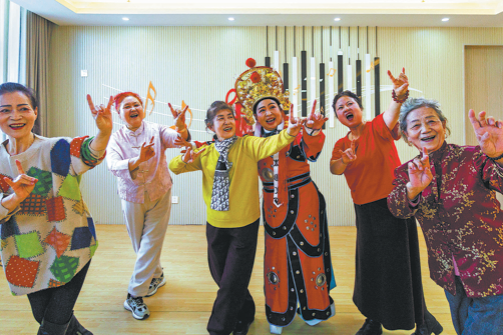Shaanxi village transformed by terrace fields
chinadaily.com.cn | Updated: 2024-06-22 19:58
On the bald mountainside of Yangjia village, Shaanxi province, only a few sparse patches of grass could be seen. When it rained, the water rushed down the slopes, carving small gullies and eroding the dirt roads, making it even more challenging for the villagers, already cut off from the outside world, to travel.
But things have changed now. The mountains are turning increasingly lush, with greenery including persimmon trees, a traditional commercial crop in the village. Meanwhile, the income of the villagers has significantly increased thanks to the remarkable expansion of persimmon planting, as part of efforts for soil erosion control.
The transformation in Yangjia village serves as a compelling example that development and conservation do not necessarily contradict but can complement each other beautifully.
"When looking into the distance, it was not easy to see a trace of green," recalled Yang Zhengchuan, a Yangjia village resident.
The barren land in the village and the severe water scarcity means that his four-member family could seldom make more than 5,000 yuan ($690) from farming, which used to be their main source of income.
The economic situation for the family was so bad sometimes in the 1990s that he even had to borrow money to buy milk powder for his two kids, the price of which only stood at 8 yuan per can then, the 55-year–old recalled.
Their life would go into chaos during heavy rains. Soil was rushed down from the bald mountains, making the road impassable. To make it worse, some parts of the road connecting the remote village to the outside world were sometimes washed out, he recalled.
That might make them go without adequate daily supplies for days, as they usually had to buy such necessities from the nearest township of Zhuangli, which is only more than five kilometers away but could take them almost a whole day for a round trip even when the road conditions were good.
Change happened to the village only after 2012, when the local government launched a program that combines soil erosion and persimmon industry development.
As part of the program, those gently slopping lands were transformed into terraced fields that villagers could contract for persimmon planting, and those other mountain slops were afforested to prevent rainwater from carrying away more soil.
The government also introduced drip irrigation systems for villagers to address the irrigation difficulties in the arid area.
Yang contracted almost 2.7 hectares of terraced fields to plant persimmon. When these trees started to bear fruit five years later, they become a constant source that brings his family about 180,000 yuan of net income a year.
Previously, villagers also planted persimmon trees in places near their farmland that could hardly be utilized to plant grain. Back then, only about 22,500 kilograms of persimmon could be harvested annually from one hectare of the trees, he said.
Yang said the good irrigation conditions for the trees in the terraced fields, however, means that the production may be more than doubled.
Despite the limited harvest before 2012, villagers found it difficult to sell the dried persimmon they made. After giving some of their preserved fruit to friends and relatives, they took what was left to fairs in Zhuangli for selling, he said.
He said now he only needs to send his dried persimmons to a cooperative named New Farmers in the village and the cooperative will buy all of his products.
With his economic conditions remarkably improved, Yang's family has said farewell to a tattered, time-honored cave dwelling and moved into a new house.
Moreover, with the mountains turning green, local people no longer have to suffer the muddy road after rains and the flying sand in case of windy weather, he said.
Going out of our hometown to work as migrant workers used to be deemed as the only way for young villagers to make a living, Yang recounted. But now they are coming back, lured by the booming persimmon industry.
"Previously, you would hardly see young people in the village. But now, it's no longer difficult to run into one," he said.
























